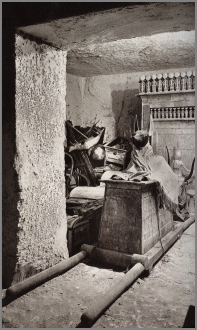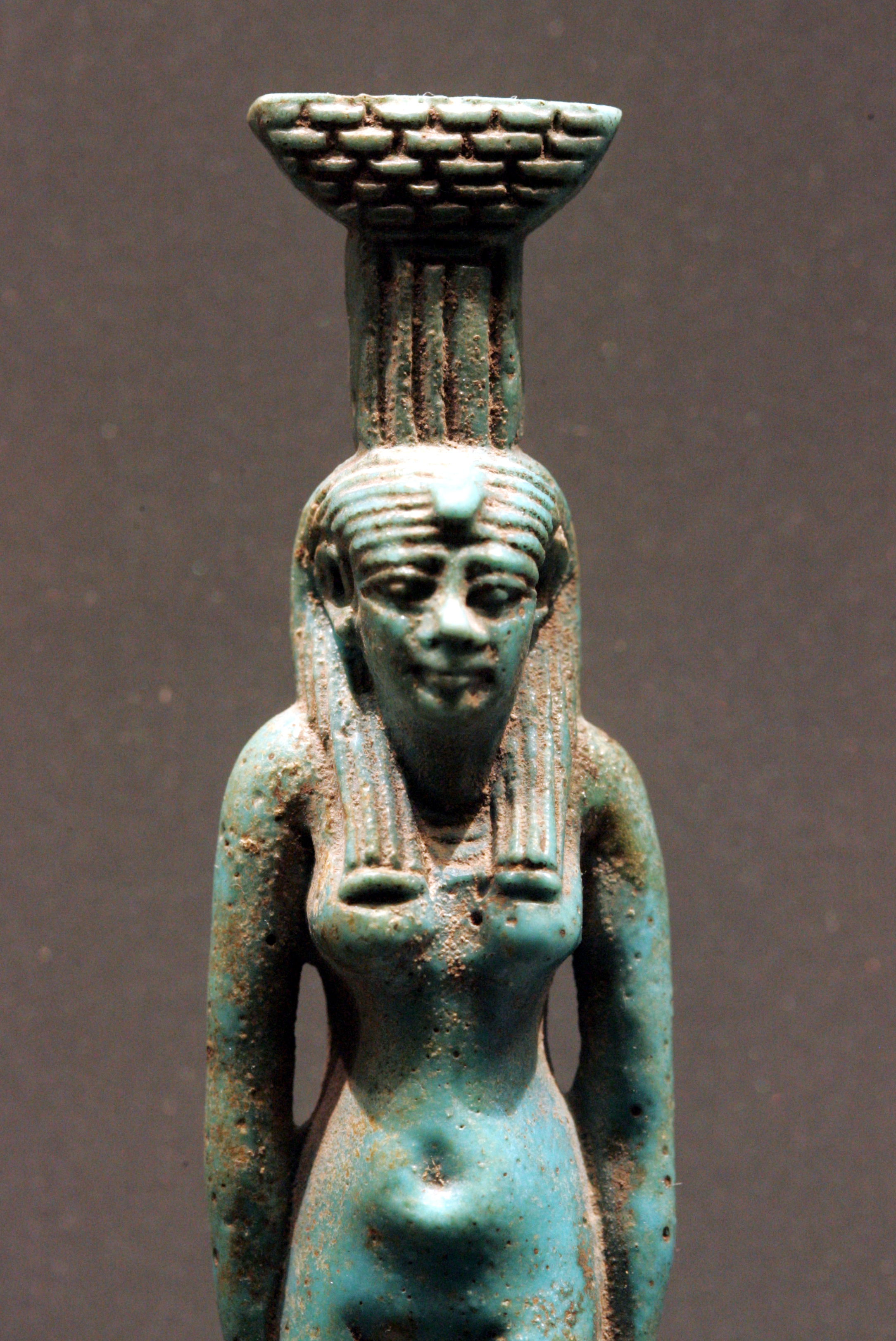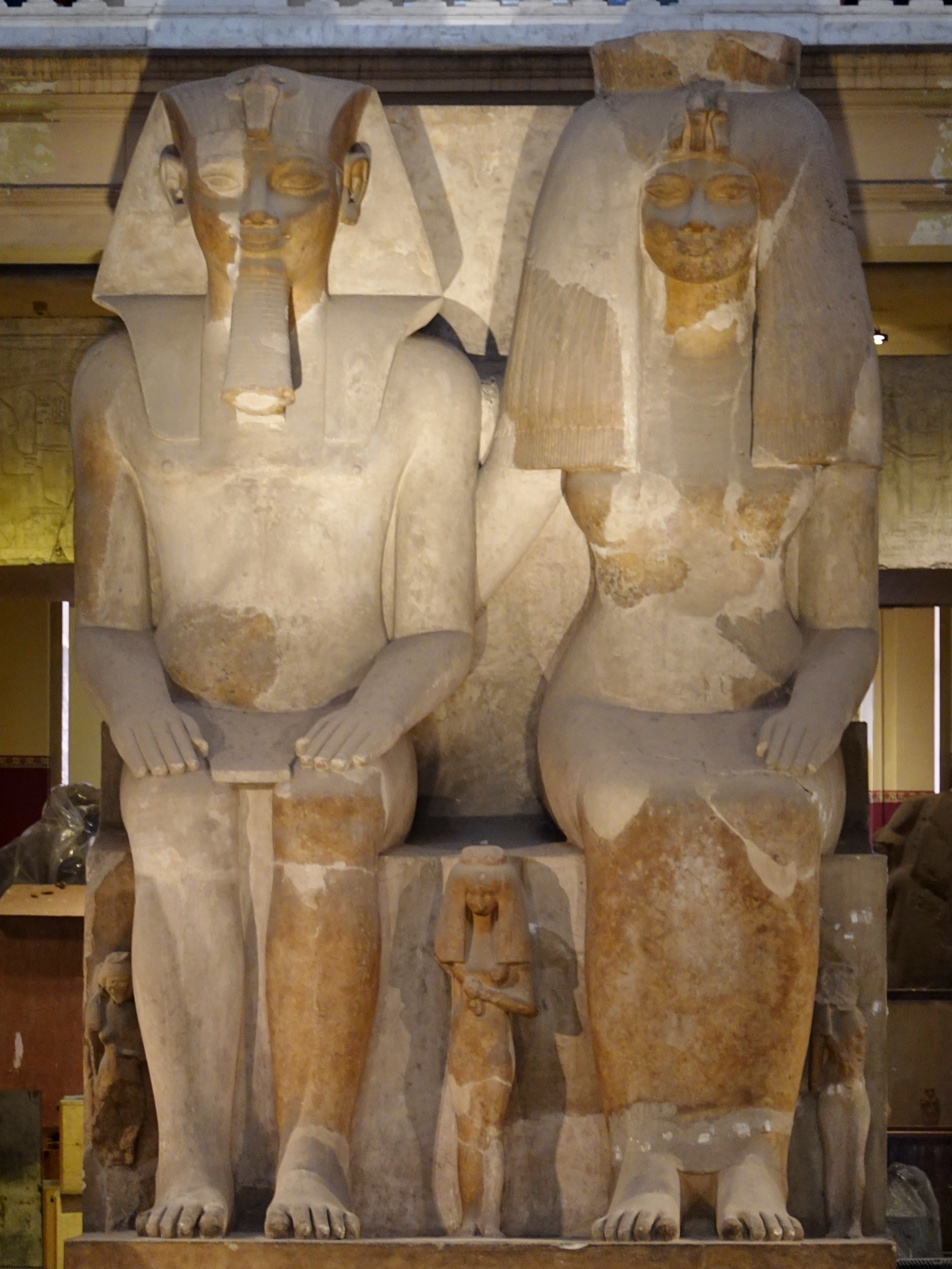|
317a And 317b Mummies
Mummies 317a and 317b are the remains of two infant daughters of Tutankhamun, a pharaoh of the Eighteenth Dynasty of Egypt. Their mother, who has been tentatively identified through DNA testing as the mummy KV21A, is presumed to be Ankhesenamun, his only known wife. 317a was born prematurely at 5–6 months' gestation, and 317b was born at or near full term. They are assumed to have been stillborn or died shortly after birth. They were buried in their father's tomb in the Valley of the Kings, which was discovered by the Egyptologist Howard Carter in 1922. Their bodies were mummified and wrapped in the same style as high-status adults and 317a was fitted with a gilded mummy mask; 317b's mask was too small for her and was found in 1907 among the leftovers from Tutankhamun's mummification and funerary feast cached in KV54. Each girl was buried in miniature two-coffin sets of the same design used by nobility. Both babies were unnamed, as the coffin inscriptions call them onl ... [...More Info...] [...Related Items...] OR: [Wikipedia] [Google] [Baidu] |
Tomb Of Tutankhamun
The tomb of Tutankhamun (reigned ), a pharaoh of the Eighteenth Dynasty of Egypt, Eighteenth Dynasty of ancient Egypt, is located in the Valley of the Kings. The tomb, also known by its List of burials in the Valley of the Kings, tomb number KV62, consists of four chambers and an entrance staircase and corridor. It is smaller and less extensively decorated than other Egyptian royal tombs of its time, and it probably originated as a tomb for a non-royal individual that was adapted for Tutankhamun's use after his premature death. Like other pharaohs, Tutankhamun was buried with a wide variety of funerary objects and personal possessions, such as coffins, furniture, clothing and jewelry, though in the unusually limited space these goods had to be densely packed. Robbers entered the tomb twice in the years immediately following the burial, but Tutankhamun's mummy and most of the burial goods remained intact. The tomb's low position, dug into the floor of the valley, allowed its entra ... [...More Info...] [...Related Items...] OR: [Wikipedia] [Google] [Baidu] |
Serology
Serology is the scientific study of Serum (blood), serum and other body fluids. In practice, the term usually refers to the medical diagnosis, diagnostic identification of Antibody, antibodies in the serum. Such antibodies are typically formed in response to an infection (against a given microorganism), against other foreign proteins (in response, for example, to a Acute hemolytic transfusion reaction, mismatched blood transfusion), or to one's own proteins (in instances of autoimmune disease). In either case, the procedure is simple. Serological tests Serological tests are diagnostic methods that are used to identify antibodies and antigens in a patient's sample. Serological tests may be performed to diagnose infections and autoimmune illnesses, to check if a person has immunity (medical), immunity to certain diseases, and in many other situations, such as determining an individual's blood type. Serological tests may also be used in forensic serology to investigate crime scene evid ... [...More Info...] [...Related Items...] OR: [Wikipedia] [Google] [Baidu] |
Nephthys
Nephthys or Nebet-Het in ancient Egyptian () was a goddess in ancient Egyptian religion. A member of the Great Ennead of Heliopolis in Egyptian mythology, she was a daughter of Nut and Geb. Nephthys was typically paired with her sister Isis in funerary rites because of their role as protectors of the mummy, with her brother Osiris, and as the sister-wife of Set. She was associated with mourning, the night/darkness, service (specifically temples), childbirth, the dead, protection, magic, health, embalming, and beer. Etymology Nephthys is the Greek form of an epithet (transliterated as ''Nebet-hut'', ''Nebet-het'', ''Nebt-het'', from Egyptian ''nbt-ḥwt''). The origin of the goddess Nephthys is unclear but the literal translation of her name is usually given as ''Lady of the House'' or ''Lady of the Temple.'' This title, which may be more of an epithet describing her function than a given name, probably indicates the association of Nephthys with one particular temple or s ... [...More Info...] [...Related Items...] OR: [Wikipedia] [Google] [Baidu] |
Usekh Collar
As early as the Old Kingdom (c. 2670–2195 B.C.), Egyptian artisans fashioned images of deities, kings, and mortals wearing broad collars made of molded tubular and teardrop beads. The Usekh or Wesekh is a personal ornament, a type of broad Collar (clothing), collar or necklace, familiar to many because of its presence in images of the ancient Egyptian elite. Ancient Egyptian deities, Deities, women, and men were depicted wearing this jewelry. One example can be seen on the famous gold Tutankhamun's mask, mask of Tutankhamun. The ancient word ''wsẖ'' can mean "breadth" or "width" in the Egyptian language, Ancient Egyptian language and so this adornment is often referred to as the broad collar. The usekh broad collar was wrapped around and supported by the neck and shoulders. It is typically adorned with closely placed rows of colored stone beads, or it is made entirely of metal. The collars were connected with clasps of gold. Over time, the broad collar went through many di ... [...More Info...] [...Related Items...] OR: [Wikipedia] [Google] [Baidu] |
Cairo University
Cairo University () is Egypt's premier public university. Its main campus is in Giza, immediately across the Nile from Cairo. It was founded on 21 December 1908;"Brief history and development of Cairo University." Cairo University Faculty of Engineering. http://www.eng.cu.edu.eg/CUFE/History/CairoUniversityShortNote/tabid/81/language/en-US/Default.aspx after being housed in various parts of Cairo, its faculties, beginning with the Faculty of Arts, were established on its current main campus in Giza in October 1929. The university was known as the Egyptian University from 1908 to 1940, and King Fuad I University and Fu'ād al-Awwal University from 1940 to 1952. The university is the second oldest institution of higher education in Egypt after Al-Azhar University, notwithstanding the pre-existing higher professional schools that later became constituent colleges of the university. The university was founded and funded as the Egyptian University by a committee of private citizens ... [...More Info...] [...Related Items...] OR: [Wikipedia] [Google] [Baidu] |
Cairo
Cairo ( ; , ) is the Capital city, capital and largest city of Egypt and the Cairo Governorate, being home to more than 10 million people. It is also part of the List of urban agglomerations in Africa, largest urban agglomeration in Africa, List of largest cities in the Arab world, the Arab world, and List of largest metropolitan areas of the Middle East, the Middle East. The Greater Cairo metropolitan area is List of largest cities, one of the largest in the world by population with over 22.1 million people. The area that would become Cairo was part of ancient Egypt, as the Giza pyramid complex and the ancient cities of Memphis, Egypt, Memphis and Heliopolis (ancient Egypt), Heliopolis are near-by. Located near the Nile Delta, the predecessor settlement was Fustat following the Muslim conquest of Egypt in 641 next to an existing ancient Roman empire, Roman fortress, Babylon Fortress, Babylon. Subsequently, Cairo was founded by the Fatimid Caliphate, Fatimid dynasty in 969. It ... [...More Info...] [...Related Items...] OR: [Wikipedia] [Google] [Baidu] |
Egyptian Museum
The Museum of Egyptian Antiquities, commonly known as the Egyptian Museum (, Egyptian Arabic: ) (also called the Cairo Museum), located in Cairo, Egypt, houses the largest collection of Ancient Egypt, Egyptian antiquities in the world. It houses over 120,000 items, with a representative amount on display. Located in Tahrir Square in a building built in 1901, it is the list of largest art museums, largest museum in Africa. Among its masterpieces are Pharaoh Tutankhamun's treasure, including its iconic Mask of Tutankhamun, gold burial mask, widely considered one of the best-known works of art in the world and a prominent symbol of ancient Egypt. History The Egyptian Museum of Antiquities contains many important pieces of ancient Egyptian history. It houses the world's largest collection of Pharaonic antiquities. The Egyptian government established the museum built in 1835 near the Azbakeya, Ezbekieh Garden and later moved to the Cairo Citadel. In 1855, Maximilian I of Mexico, ... [...More Info...] [...Related Items...] OR: [Wikipedia] [Google] [Baidu] |
Cartonnage
Cartonnage or cartonage is a type of material used in ancient Egyptian funerary masks from the First Intermediate Period to the Roman Empire, Roman era. It was made of layers of linen or papyrus covered with plaster. Some of the Fayum mummy portraits are also painted on panels made of cartonnage. Technique In a technique similar to papier-mâché, scraps of linen or papyrus were stuck together with plaster or resin and used to make mummy cases and masks. It could be molded to the shape of the body, forming a type of shell. After the material dried it could be painted or gilded. The shell could be decorated with geometric shapes, ancient Egyptian deities, deities, and inscriptions. During the Ptolemaic Kingdom, Ptolemaic era, the single shell method was altered to include four to six pieces of cartonnage. There would generally be a mask, pectoral, apron, and foot casing. In certain instances there were two additional pieces used to cover the ribcage and stomach. Materials The ma ... [...More Info...] [...Related Items...] OR: [Wikipedia] [Google] [Baidu] |
Linen
Linen () is a textile made from the fibers of the flax plant. Linen is very strong and absorbent, and it dries faster than cotton. Because of these properties, linen is comfortable to wear in hot weather and is valued for use in garments. Linen textiles can be made from flax plant fiber, yarn, as well as woven and knitted. Linen also has other distinctive characteristics, such as its tendency to wrinkle. It takes significantly longer to harvest than a material like cotton, although both are natural fibers. It is also more difficult to weave than cotton. Linen textiles appear to be some of the oldest in the world; their history goes back many thousands of years. Dyed flax fibers found in a cave in the Caucasus (present-day Georgia (country), Georgia) suggest the use of woven linen fabrics from wild flax may date back over 30,000 years. Linen was used in ancient civilizations including Mesopotamia and ancient Egypt, and linen is mentioned in the Bible. In the 18th century and be ... [...More Info...] [...Related Items...] OR: [Wikipedia] [Google] [Baidu] |
Tiye
Tiye (c. 1398 BC – 1338 BC, also spelled Tye, Taia, Tiy and Tiyi) was the Great Royal Wife of the Egyptian pharaoh Amenhotep III, mother of pharaoh Akhenaten and grandmother of pharaoh Tutankhamun; her parents were Yuya and Thuya. In 2010, DNA analysis confirmed her as the mummy known as "The Elder Lady" found in the tomb of Amenhotep II (KV35) in 1898. Family and early life Tiye's father, Yuya, was a non-royal, wealthy landowner from the Upper Egyptian town of Akhmim, where he served as a priest and superintendent of oxen or commander of the chariotry. Tiye's mother, Thuya, was involved in many religious cults, as her different titles attested (''Singer of Hathor'', ''Chief of the Entertainers'' of both Amun and Min...), which suggests that she was a member of the royal family. Egyptologists have suggested that Tiye's father, Yuya, was of foreign origin due to the features of his mummy and the many different spellings of his name, which might imply it was a non-Egypt ... [...More Info...] [...Related Items...] OR: [Wikipedia] [Google] [Baidu] |
Ushabti
The ushabti (also called shabti or shawabti, with a number of variant spellings) was a funerary figurine used in ancient Egyptian funerary practices. The Egyptological term is derived from , which replaced earlier , perhaps the nisba of "''Persea'' tree". Ushabtis were placed in tombs among the grave goods and were intended to act as servants or minions for the deceased, should they be called upon to do manual labor in the afterlife. The figurines frequently carried a hoe on their shoulder and a basket on their backs, implying they were intended to farm for the deceased. They were usually written on by the use of hieroglyphs typically found on the legs. They carried inscriptions asserting their readiness to answer the gods' summons to work. The practice of using ushabtis originated in the Old Kingdom of Egypt ( to 2100 BC), with the use of life-sized reserve heads made from limestone, which were buried with the mummy. Most ushabtis were of minor size, and many produced in ... [...More Info...] [...Related Items...] OR: [Wikipedia] [Google] [Baidu] |








